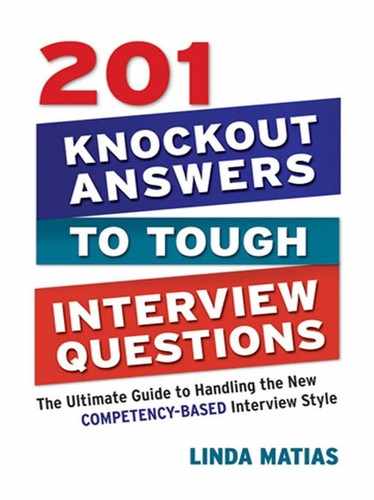Introduction
The job interview. It’s a constantly evolving environment. Just when candidates think they have figured it all out, they are exposed to competency-based interview questions (also known as behavioral-style interviews) that leave them clueless as to how to respond.
Competency-based interviews are quickly gaining popularity among hiring professionals as the most effective questioning strategy to identify and hire the right people. But what are competency-based interviews and how do these interviews work? Competency-based interviews are when interviewers focus on core competencies that are essential for success on the job. In addition, behavioral-style interview questions target the candidates’ accomplishments, which gives them an opportunity to showcase their successes.
This book presents 201 competency-based interview questions that you are likely to be asked so you will know the best way to answer these questions. This book provides the tips and guidance you need to succeed in today’s competitive marketplace. To make it easier to navigate through the book, the information is split into three parts.
Part I: The Fundamentals. Whenever a new interview method, such as the competency-based interview, is introduced, it’s normal for applicants to feel insecure. The key is to not let self-doubt get the best of you, lest you run the risk of getting tongue-tied and making a poor impression. Filled with easy-to-grasp concepts and easy-to-follow advice, Part I effectively prepares you to enter this new world of interviewing.
Part II: Competency-Based Questions and Answers. This part of the book is its core. With these 201 interview questions and answers, you will come away with a clear understanding of how to broach this type of questioning strategy. Each answer has three components: situation, action (or observation), and result. The breakdown of competencies, along with the questions and typical answers, provides you with a variety of objectives and sample responses you can use as a guide when preparing for interviews.
Part III: The End of the Interview. The way you manage the end of the interview, and the course you take once the interview is over. can have a significant impact on whether or not you are offered the position. Complete with a post-interview analysis, this section provides scripts on how to close the interview and sample follow-up letters you can tailor to fit your situation.
Key Attributes and Career Values
Key attributes and career values are personal characteristics and work strengths that employers will measure during job interviews. In the body of this book you will learn how to identify your fundamental competencies and shape each to appeal to employers. However, to begin, you can use your current job description to identify your employment-based traits and your basic career values. Here’s how to do it:
Step 1. Pull out your job description and jot down your duties and responsibilities.
Step 2. Write down the actions you take to accomplish each duty.
Step 3. Identify the career values and key attributes important to each.
As an example, see Figure I-1. This shows what one person, presently working as a quality assurance manager, came up with when he followed the three steps just described. As you can see, he took his current job description (to create a safe environment, to conduct OSHA meetings, and to file accident reports) and paired those duties with the actions he took to perform those duties and the employer-desired values and key employee attributes inherent in those actions.
Gathering this job information and viewing it in this manner—in terms of key attributes and career values—will provide you with the resources you need to answer the kinds of competency-based questions that have been presented in this book.
The Competency-Based Questions
Chapters 6 through 10 present the 201 questions and give sample responses, keyed to the Key Attributes and Career Values described above. As a further aid, I have presented just the questions in the following section—you might see how well you can answer them right now, even before beginning to read this book. Then compare your initial responses with those in the chapters that follow.
In this increasingly competitive world, securing a job position—especially the position that you want and that will advance your career—requires solid communication skills and the ability to answer these tough competency-based questions. With this guide you will be well on your way to getting that job offer. Good luck!

